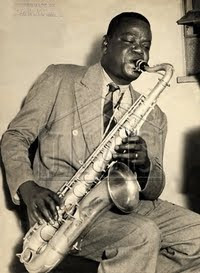The Violão Tenor Dinâmico
 According to several sources, Garoto (Anibal Augusto Sardinha, 1915-55) introduced the tenor guitar in Brazil. Garoto had acquired a Triolian metal body 4 string tenor guitar similar to the one shown above, manufactured by the American National Instruments company, in 1933, but he was later to use a Brasilian made instrument of the same 'family', for which he is best known from numerous recordings during the 1930s and throughout his career, the Del Vechio tenor dinãmico.
According to several sources, Garoto (Anibal Augusto Sardinha, 1915-55) introduced the tenor guitar in Brazil. Garoto had acquired a Triolian metal body 4 string tenor guitar similar to the one shown above, manufactured by the American National Instruments company, in 1933, but he was later to use a Brasilian made instrument of the same 'family', for which he is best known from numerous recordings during the 1930s and throughout his career, the Del Vechio tenor dinãmico. This instrument was manufactured by the luthier Del Vechio of São Paulo from the mid-1930s and represents a modified issue of the American prototype. The biggest difference between the American and the Brasilian instrument is that the Triolian used steel for the body, while the Del Vechio body is made of wood. Both instruments have build in resonator 'cones' instead of the common sound hole, a kind of acoustic amplifying system, which aids in distributing the sound and makes it loud to the benefit of the musician playing in an ensemble of other instruments. The sound of the Del Vechio dinãmico is almost similar to the sound generated by a dobro and instantly recognisable. - Here's a video performance featuring a dobro that gets close to the sound:
This instrument was manufactured by the luthier Del Vechio of São Paulo from the mid-1930s and represents a modified issue of the American prototype. The biggest difference between the American and the Brasilian instrument is that the Triolian used steel for the body, while the Del Vechio body is made of wood. Both instruments have build in resonator 'cones' instead of the common sound hole, a kind of acoustic amplifying system, which aids in distributing the sound and makes it loud to the benefit of the musician playing in an ensemble of other instruments. The sound of the Del Vechio dinãmico is almost similar to the sound generated by a dobro and instantly recognisable. - Here's a video performance featuring a dobro that gets close to the sound: 
Garoto may have been the first to use the Del Vechio tenor dinãmico in recordings and live performance, but he was soon followed by other musicians that would take advantage of the special sound generated by the instrument, a.o. Zé Menezes and Claudionor Cruz. But few professional musicians have devoted their talents entirely to the tenor dinãmico, an exception, however, was Álvaro Brochado. - Álvaro Brochado Hilsdorf (1923-1997) started his career playing violão, bandolim and the tenor banjo, but soon concentrated on the violão tenor and therefore was known as “Álvaro do Violão Tenor”. He worked as a staff musician at local radio stations (Rádio Jornal Primavera and Rádio Clube de Rio Claro), but was soon featured at radio networks in São Paulo and Rio as well after touring Brazil accompanying vocalist Euclides Alves. At one point he met with and became a friend of Garoto, which caused in a curious pact between the two musicians: The first of them to pass away would be honored by the other through a recording. In this way Àlvaro Brochado's first LP, Homenagem a “Garoto”, was initiated and recorded including a choro composition by Brochado paying homage to Garoto, "Exaltação a Garoto". Álvaro Brochado recorded several LPs and a couple of cds during his career, all of them devoted to his prefered instrument, the Del Vechio tenor dinãmico, and the traditional choros and waltzes by renown Brasilian composers besides selfcomposed pieces in the tradition. Learn more from the website dedicated to the legacy of Álvaro do Violão Tenor (- in Portuguese), click here

Unfortunately, none of the recordings by Álvaro Brochado seem to be commercially available today, and I have not found any video material featuring this artist. However, to end this entry I insert a couple of video fragments featuring the Del Vechio tenor dinãmico in action. The first is a re-up from a TV performance featuring a young Alessandro Penezzi with Conjunto Som Brasileiro playing "Numa Seresta", a choro by Luiz Americano
The last video this time is recorded earlier this year at Clube Do Choro De Londrina featuring Robertão ( Violão), Alberto ( Cavaquinho), Cabeção ( Violão Tenor). The music is the well known waltz by Dilermando Reis, "Se Ela Perguntar"
Jo



.jpg)

